
Organizations work better with Roles
How can organizations benefit from working with Roles? How can they scale and grow more agile with Roles? How does working with Roles enable companies to distribute decision-making authority and become more resilient? And why is that a good thing for a founder or CEO?
Roles provide clarity on who does what
Thousands of organizations worldwide use Roles to build agile, self-organizing teams. Popular agile work methods for teams, such as ‘scrum,’ use Roles to create clear work packages that are delegated to team members. Roles create clarity for team members. They contain clearly defined duties and responsibilities, so team members know what is expected from them and what they can expect from others.
And this clarity goes beyond the team. Making responsibilities transparent also benefits colleagues outside the team.
Find the right person faster
If you know the Roles a team has and the responsibilities each Role has, finding the right person becomes easy. Communication gets more effective, and less time is wasted on misunderstandings due to talking to the wrong person.
Make responsibilities transparent in Role-up
When you use Role-up for your organization, all teams can manage their Roles in one place. Role-up generates a dynamic graph of your teams that is always up to date. You can see the members of each team and who are the persons linking the two teams.
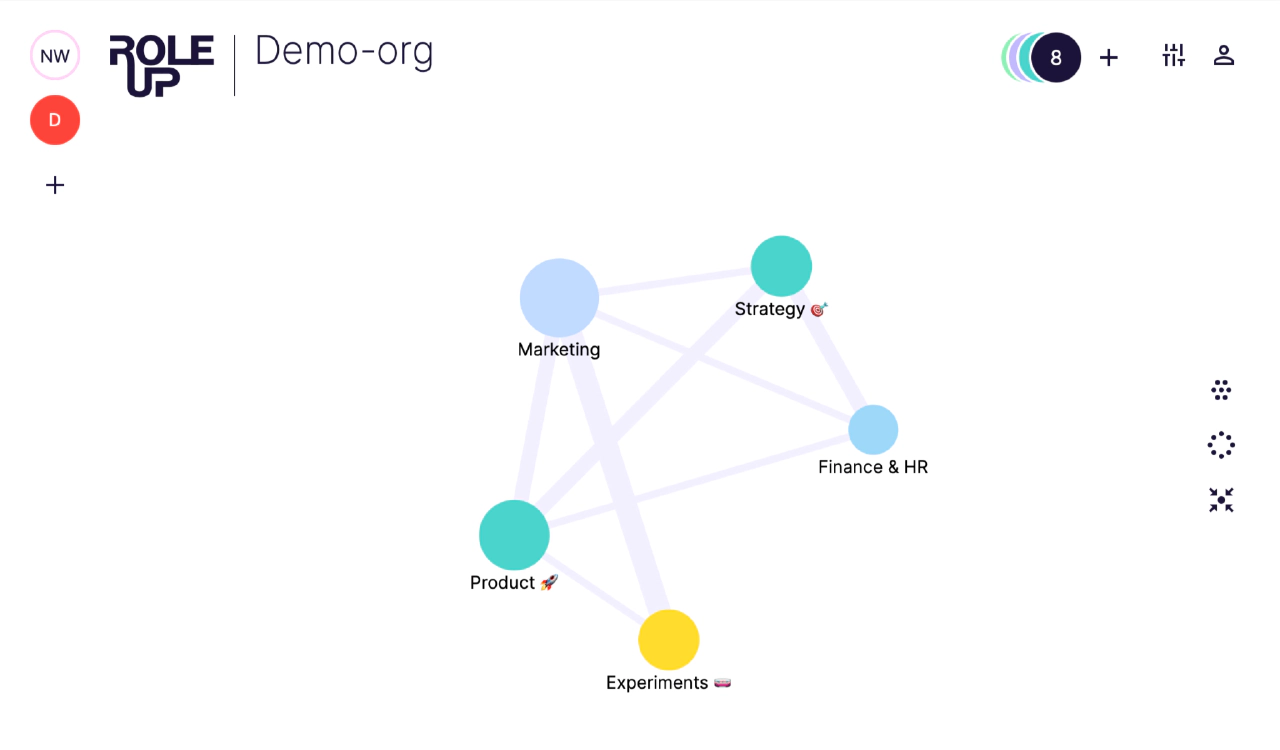
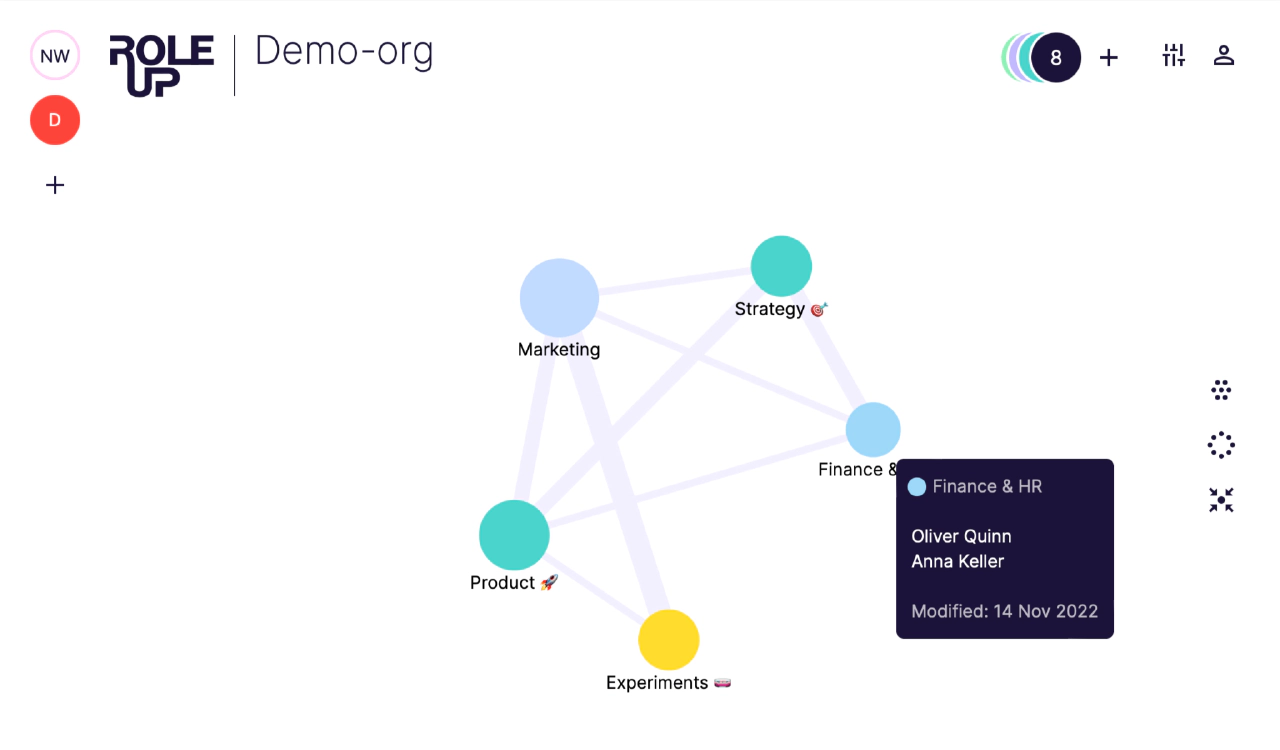
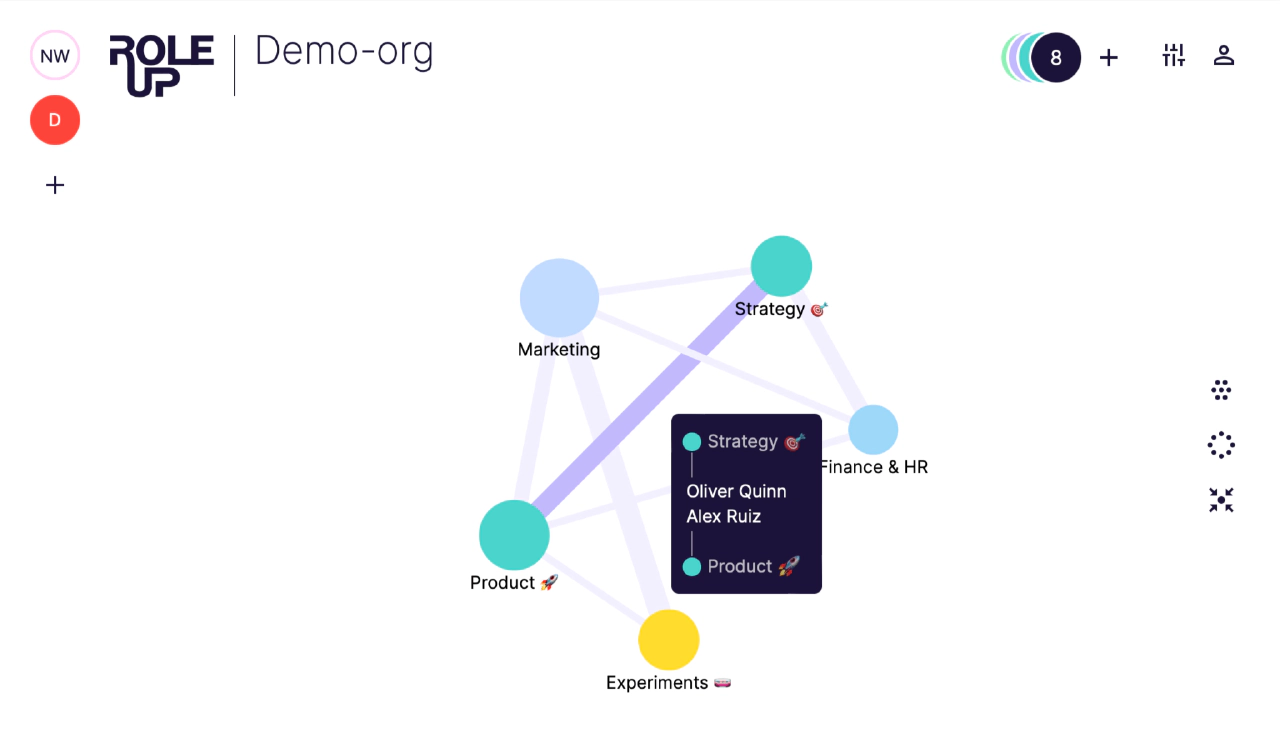
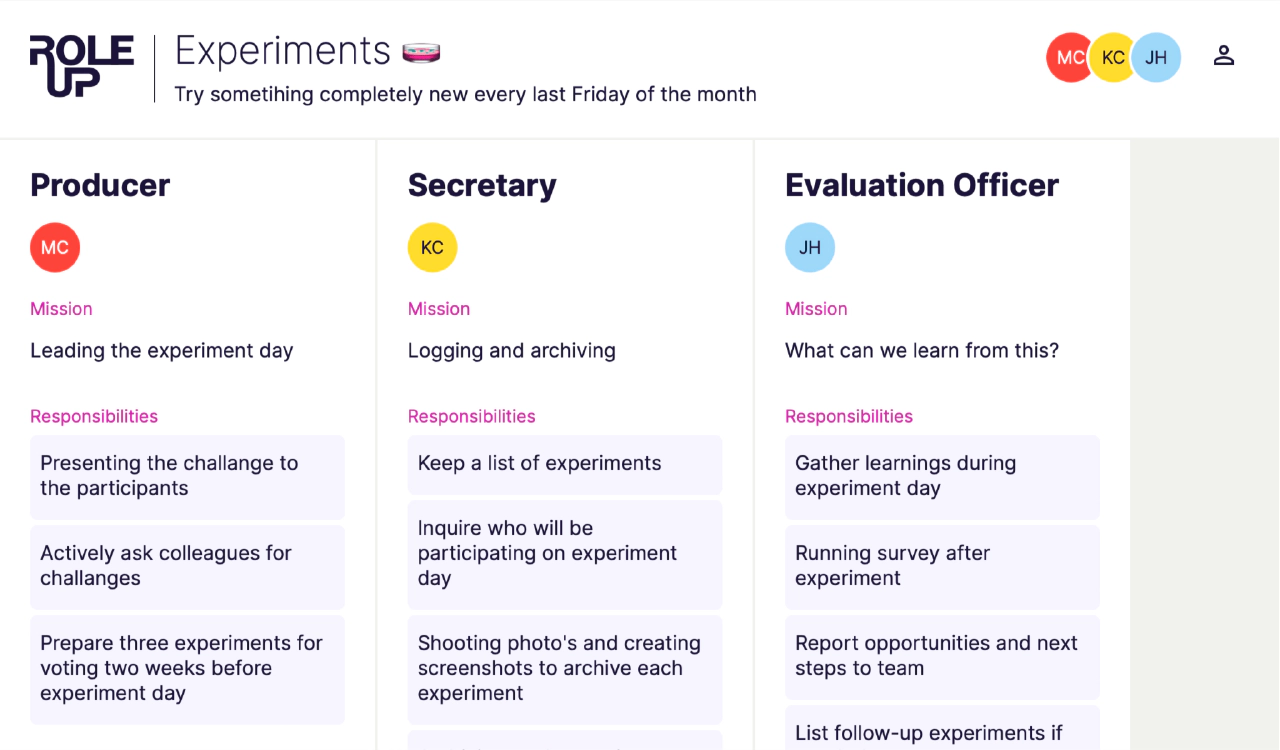
When you click on a team, you can view all the Roles they created, the listed responsibilities per Role, and to whom the Role is delegated. Role-up becomes a complete overview of all accountabilities in your entire organization.
Grow organically with Roles
When you start in Role-up—maybe with only one team—listing responsibilities and assigning Roles to team members may feel obvious. Why should you write down what everybody already does and knows, right? But when new members join the team, they will better understand how the team works together. For everyone who was not there in the beginning, the organization of the work is clearly defined in Roles.
And there might be a second team at some point. Or maybe a few new teams when Roles that were part of the founding team evolve into small business units. Suddenly there are many places where Roles are updated and refined by teams. Role-up will be your central overview of all your organization’s teams and Roles. It will grow with your organization as your teams, and the layout of your organization evolve.
More effective communication
Having a central source of truth regarding responsibilities has many benefits. It makes connecting to the right person in another team easier. Teams can communicate more effectively, and less time is wasted searching for the right person. Or talking to the wrong persons.
In the dynamics of a growing organization, responsibilities, Roles, and teams change often. Role-up provides the central online overview of who is accountable for what.
Distributing authority with Roles
Roles do more than bring clarity to work and make responsibilities findable and transparent. They allow you to distribute decision-making authority. What does that mean? And why is this so important for companies?
In a traditional setting, when a team needs a decision, they will ask their project manager. The project manager will probably ask his manager, who will ask her boss, etc., until the request reaches the person who is allowed to make the decision. This person with decision-making authority will ask for advice from specialists (possibly someone from the team requesting the decision in the first place) and then make a decision. Subsequently, the decision travels through the organization’s hierarchy back to the team.
Reduce information travel
This process takes a lot of time. When information travels through an organization, it usually means meetings. The project manager has a meeting with his manager, the manager with her boss, etc. There will also be some emails that require reading and writing time. During all this time, no decision is taken, and the team in need of a decision can’t move forward on the matter.
Why not give the team the power to make the decision? When you work with Roles, you can delegate decision-making to a specialist filing the Role. The person who makes the decision has to scrutinize the pros and cons. This includes the consequences of the decision on other teams or projects. That is not something only managers can do. If the people who need a decision can do this work and make it themselves, you save time. You reduce information travel and empower your teams to react swiftly.
Reduce dependencies on decision-makers
But there is more good news. Distributing decision-making to the places in your organization where the decision is needed frees up time elsewhere. CEOs, founders, and other decision-makers get a break. They no longer have to understand what they have to decide, collect advice to enable an informed decision, and communicate their decision after making it. Someone else does all that work now. When C-level managers can outsource areas of decision-making to other Roles in the organization, they can focus on work only they can do.
Make your organization agile and resilient
When you start distributing decision-making, decisions are taken faster. Teams become more agile and can adapt to changes more quickly.
By making decisions faster and in more places, your organization can react quickly to changes in the world around you. Teams can process insights and iterate until they get it right. Distributed decision-making helps companies, non-profits, and all types of organizations to become more responsive to change.
When your teams can adapt faster to market demands or customer needs, your organization will become more agile. You can change direction more quickly and efficiently. Your organization becomes more resilient. When impactful external changes occur, your organization can recover faster, bounce back and find new ways to achieve its goals.
The potential of self-management
Outsourcing decision-making to specialists in your organization is a first step towards self-management. There are many inspiring examples of companies and non-profit organizations that implemented self-management. There are numerous ways to do it and many methodologies to review.
Popular methodologies such as Holacracy and sociocracy all share a crucial building block: working with Roles. Roles form the basis of these modern ‘operating systems’ for organizations. But you don’t have to start a reorganization or hire a consultant to begin reaping the fruits of working with Roles. With Role-up, you can start today. We created an easy-to-follow workshop template to get your team started.
Work better together with Roles
Curious about how to begin? Read about the advantages working with Roles brings to teams.
Start creating the structure that will allow your company to scale, grow agile and become resilient. Your organization will work better with Roles.
Why others do it
A growing number of companies and non-profits start working with Roles. Why do they switch to this new way of working? We did some digging and found Seven Reasons ogranizations have for switching to working with Roles.

Last updated on
More Resources
-
Introduction to Working with Roles
A brief introduction to bring you up to speed in 2 minutes. What are Roles? How can you work with Roles? How are they used for self-management in Holacracy and sociocracy, and how can working with Roles benefit your team?
Learn the basics in 2 minutes -
Workshop: Start working with Roles
This easy-to-follow guide will help you to organize a workshop for your team. You will create and assign roles and list responsibilities. Open workshop guide -
How to run an effective
Once your team has defined its Roles and responsibilities, how do you keep them up-to-date? The answer is a recurring governance meeting! Read on to learn what a governance meeting is and how to run one effectively. Run effective governance meetings
Governance Meeting -
Working with Roles as a team
How can teams use Roles to work better together? What are the benefits of working with Roles for teams? How can working with Roles help your team to reduce friction and irritation, improve communication, have fewer meetings, and deliver more value?
Read about working with Roles as a team -
Why every Agile team
should use Role-up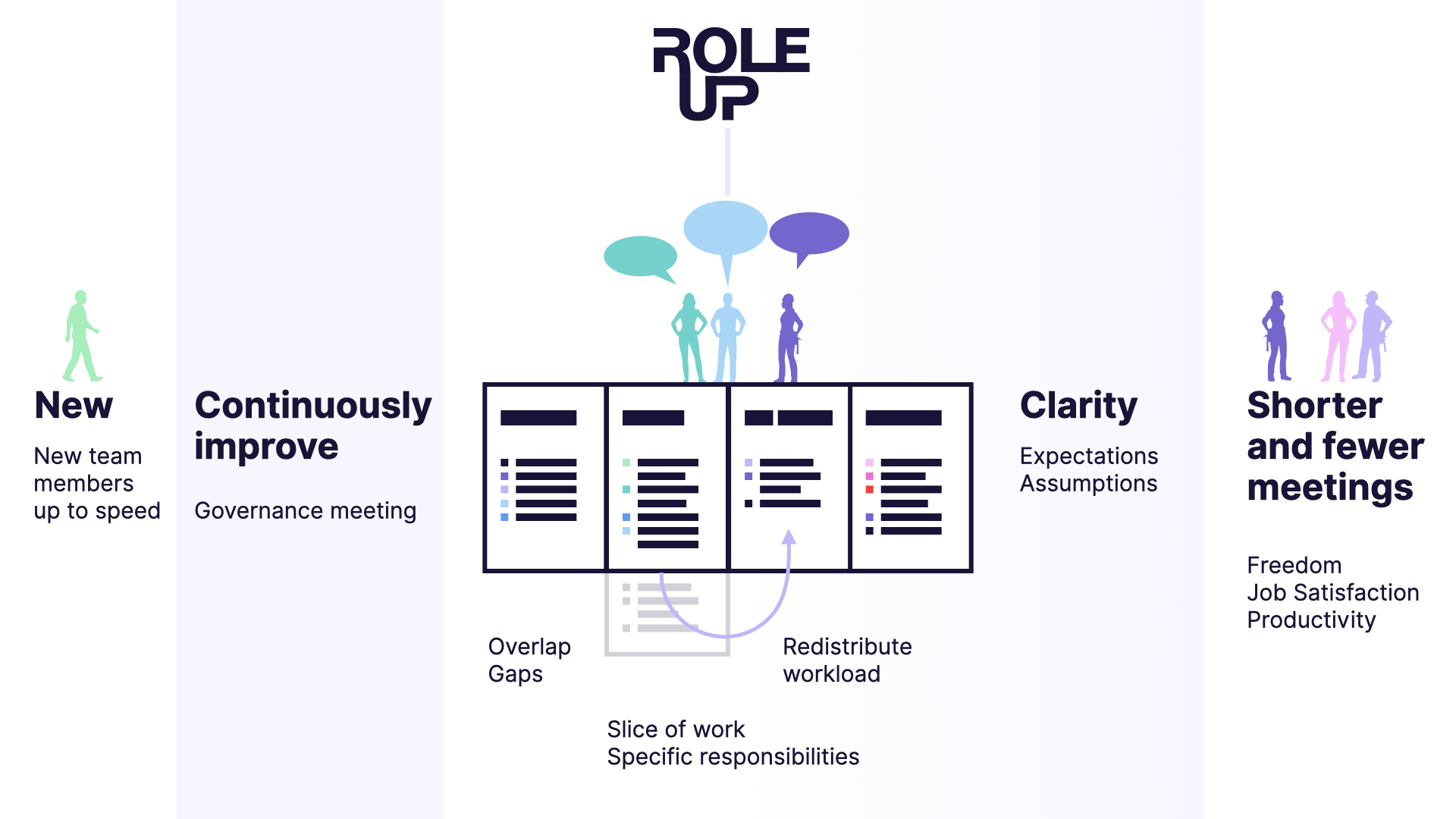
Watch our video about why every team that works agile should use Role-up and experience the advantages of working Role-based.
See why every agile team should use Role-up -
Seven reasons organizations start working with Roles
A growing number of organizations have switched to some form of self-management. This can be Holacracy, sociocracy, or other practices. What makes these companies transition to working with Roles? What frustrations and annoyances motivate this change?
Find out what we discovered -
Retrospective: Roles and Responsibilities
Does your scrum team have team members who avoid talking to each other? Is passive-aggressive behavior getting in the way of good teamwork? Are there irritations between team members? This article provides a Role-based sprint retrospective format that helps your team work better together.
Check out the exercise -
Get help from a Professional
There are professionals who can help you with setting up Roles, creating robust governance structures, and improving how you work together with your team.
View the list of professionals








